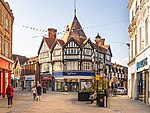Guildhall, Wrexham
1961 establishments in WalesBuildings and structures in WrexhamCity and town halls in WalesCounty halls in WalesGovernment buildings completed in 1961 ... and 2 more
Politics of WrexhamUse British English from May 2023

The Guildhall (Welsh: Neuadd y Dref; lit. 'Town Hall') is a municipal building in Wrexham, Wales. It is located in the city centre alongside the Llwyn Isaf open space. It is the headquarters of Wrexham County Borough Council and is the administrative centre of Wrexham County Borough, as it was of its predecessor Wrexham Maelor.
Excerpt from the Wikipedia article Guildhall, Wrexham (License: CC BY-SA 3.0, Authors, Images).Guildhall, Wrexham
Queens Square, Wrexham City Centre
Geographical coordinates (GPS) Address Nearby Places Show on map
Geographical coordinates (GPS)
| Latitude | Longitude |
|---|---|
| N 53.04747 ° | E -2.99387 ° |
Address
Wrexham Guildhall
Queens Square
LL11 1AY Wrexham, City Centre
Wales, United Kingdom
Open on Google Maps










